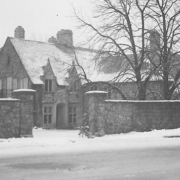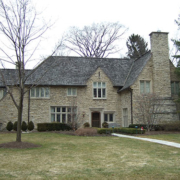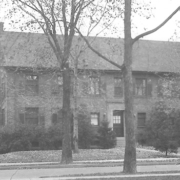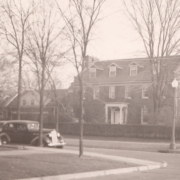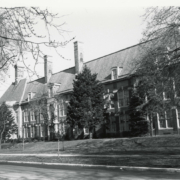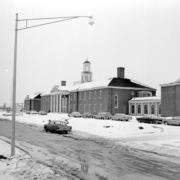Historical Architecture of Grosse Pointe – 78 Lake Shore
Last week we featured the work of a lesser-known designer Joseph P. Jogerst. Born in Marathon, Wisconsin in 1884, he created at least two homes in Grosse Pointe Park – 1006 Whittier Rd and 1000 Devonshire – and was a leading name in the design of apartment buildings in Metro Detroit during the 1920’s, and the mid 1940’s.
This week we head to an outstanding home in Grosse Pointe Farms, 78 Lake Shore. The French Normandy style home was completed in 1928, by the multi-talented Hugh T. Keyes for Marie Fleitz Dwyer, the widow of Francis T. Dwyer. It is one of the finest examples of French Normandy architecture in the Grosse Pointe communities – the French Normandy style had become popular in the U.S shortly after the First World War when French chateaus were a “model of inspiration”. Typical traits of this approach include a steeply pitched roof, stone or brick façade, an arched opening to the main entrance, tall flat chimneys, along with an asymmetrical configuration to the home.
78 Lake Shore is constructed from limestone. The slate, on the steeply pitched roof, decreases in size as it reaches the peak (a technique that also is heavily used in the roofs of Cotswold homes in England). The top of the roof (which is flat) is copper, as are the drainpipes. Both the roof and the drainpipes have developed a verdigris patina, a perfect complement to the limestone. An intricate stone carving frames the front door (a popular feature on some of Keyes work), the original windows were lead framed. The exterior also features a three-car garage, also built of limestone with a steep, slate roof, along with a sloped cobbled driveway, and a high stone wall around the front of the property. Image are courtesy of: digitalcollections.detroitpubliclibrary
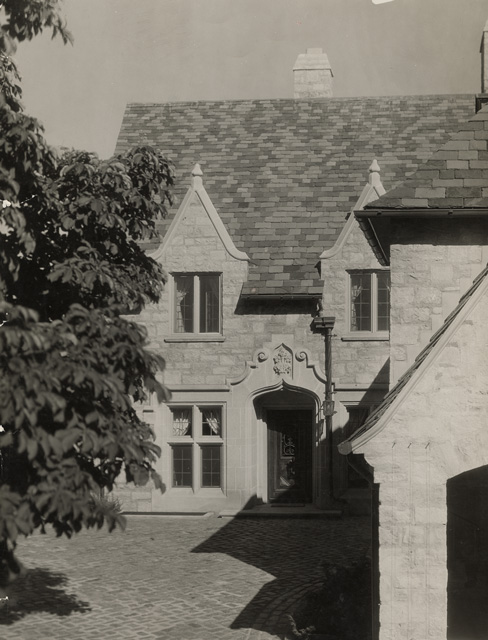

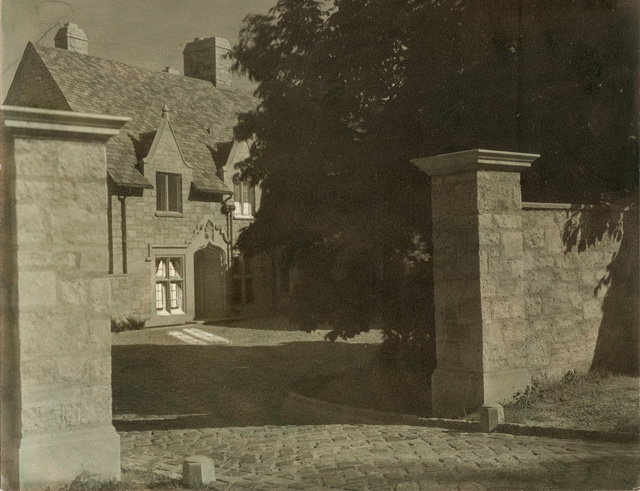
It is believed the original floorplan of the 6,317 sq ft home, had five bedrooms, and five full bathrooms, along with additional servants’ quarters. “The first floor features a unique circular floor plan, a curved 9’ x 24’ sq ft hallway, a step-down 32’ x 19’ sq ft living room, a sweeping staircase, multiple fireplaces, and 150-year-old mantelpieces imported from France”. It is reported, “when the house was completed it was the first house in the area to be wired for a telephone, along with housing a circuit board in the garage for the neighborhood phones”. Source: Grosse Pointe Historical Society. The walls in the sitting room are lined with carved paneling. It is also reported, in an article in the Detroit Free Press, by Judy Rose (2015), “some of the intricate carving had gold leaf under it”. The article also describes the 15’ x 26’ sq ft dining room with its antique paneling, and a fireplace that is believed to have been reclaimed from another mansion. “Inset on each side of the fireplace, in the dining room, are two stained-glass windows that show saints”. A second fireplace, also reclaimed, is in the bathroom upstairs. Source: Detroit Free Press, 2015.
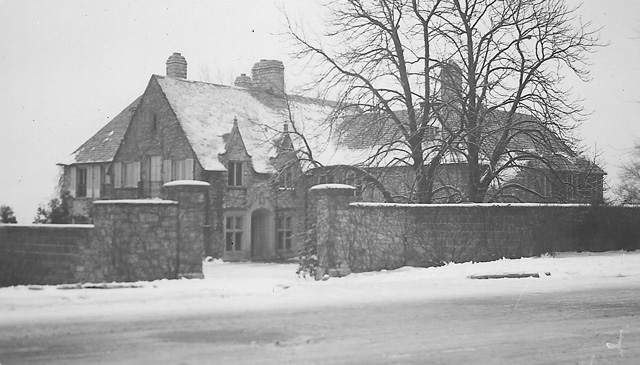



Gail Sidlek, who owned at the property between 1975 – 2017, explained that when the water is clear there are remnants visible of the original dock that extended into the lake by at least 100 feet – the photos below show the dock and the boathouse on Lake Shore prior to the construction of 78 Lake Shore. The impeccable grounds, now feature a Koi Pond that is made up of material salvaged from a Detroit skyscraper (installed by Mr. Sidlek). Mr. Sidlek also added a tall, raised viewing platform, converted from what used to be a boat hoist. Photos are courtesy of Gail Sidlek.



78 Lake Shore was commissioned by Marie Louise Dwyer (Fleitz), the widow of Francis Thomas Dwyer. Marie was the daughter of a Michigan lumber baron and grain merchant, while Francis (born in 1869) was the son of a successful iron stove manufacturer. The couple married in 1900. In 1909, Francis founded the Standard Foundry. He was also a director of the Peninsular Stove Company, and founder of the National Bank of Commerce. In 1912, at the age of 43 Francis Dwyer died unexpectedly, he was survived by his wife Marie and their eight-year-old daughter Marion.
Following her husband’s death, it is reported Marie moved to 81 Lake Shore, along with her daughter Marion, her sister, and brother-in-law. In 1924, Marion married Charles Louis Palms Jr. Charles was a member of the Palms family, a high society family from Detroit who had created a significant architectural legacy in the city – the family had built the Palms Apartments, the Palms Theatre (now the Fillmore Theater), along with being involved in banking, and the manufacturing of automobiles.
In 1928, Marie Louise Dwyer commissioned 78 Lake Shore, a house she would share with her daughter, Marion, and her son-in-law Charles. It was located just down the road from her existing home. In 1929, Marie Louise moved into her new home, shortly followed, in 1931, by her daughter and son-in-law. The house became known as the “Dwyer/Palms House”. In 1934, our files indicate the Dwyer/Palms family would consider selling the property for $200,000 (around $4.3m today). However, the property wasn’t listed for sale, and research by the Grosse Pointe Historical Society confirms the Palms raised a family of five children. They officially took ownership of the home in 1958, after Marie Louise passed. The Palms family continued to reside at the property until 1962. The Greiner family then owned the house until 1975, at which point it was purchased by Gail Sidlek who owned the residence for over 40 years. It was sold in 2017.
Hugh T. Keyes, the architect of 78 Lake Shore, had a long and distinguished career. He built many significant houses across Metro Detroit and was a prolific designer of fine homes in the Grosse Pointes. Keyes was arguably one of the most diverse architects to ply his trade in the community. His work centered on creating grand estates for the industrialists of Metropolitan Detroit and he was considered one of the most versatile architects to work in southeastern Michigan. Having worked for some of the most renowned architects (Albert Kahn, C. Howard Crane, and Smith, Hinchman, and Grylls) in Detroit during the early 20th century, Keyes opened his own office in Detroit in 1921. During this period of his career Keyes primary focus was residential projects. His earlier work involved numerous architectural styles. Arguably one of his most charming projects in Grosse Pointe during this era was the Italian Renaissance Villa – 221 Lewiston – you can read the full story by clicking here.
Prior to 1930, Keyes was also heavily influenced by Tudor, French Renaissance, and formal Georgian styles. However, during the late 1930’s, Keyes switched to international style homes, which was followed by his trademark Regency Moderne style that he would ultimately become most noted for.
78 Lake Shore is a grand home, it has been featured in numerous automobile ads, and the home and grounds have been used as a location for at least two movies.
*Photos courtesy of the Higbie Maxon Agney archives unless stated.
** Research, information, and data sources are deemed reliable, but accuracy cannot be fully guaranteed.
Written by Katie Doelle
Copyright © 2022 Katie Doelle

